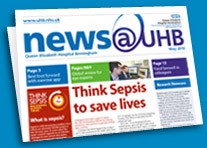Your views

Your feedback is vital to us as we continue to increase the quality of our services.
You are here:
Date: 7 March 2025
Time: 03:31
Apprentices wow hospital staff
Story posted/last updated: 28 November 2012
Teams of BAE Systems apprentices from around the UK wowed a former soldier and staff at the Queen Elizabeth Hospital Birmingham (QEHB) with the rehabilitation devices they’ve created to help military patients.
The teams from the global defence, security and aerospace giant were tasked by the hospital’s official charity with creating one of two devices to benefit wounded service personnel being cared for at the hospital. The first challenge was to develop a piece of equipment to aid an injured person or amputee's rehabilitation through bed-based exercises. The second was to build a device for patients who are restricted to lying on their backs and are unable to move their heads. The idea was that the tool should increase a patient's view of their surroundings and help them interact more easily with others.
Charity staff gave the teams tours of the hospital and showed them the equipment the patients currently use.
Three teams returned to the hospital to demonstrate their completed devices to former soldier Karl Hinett, who was badly burned on duty in Iraq, Critical Care Matron Helen Gyves and Neurosurgical Occupational Therapist Laura Pell.
Helen said: “We were all very impressed with the high standard of the prototypes we saw. The teams had clearly listened to the briefs we and the QEHB Charity gave them and developed devices which showed real potential.
“Military patients use exercise as their driver to succeed so to be trapped in a bed is frustrating for them. The first bed-based exercise device had potential to be adapted for patients with multiple limb loss or compromised skin on their hands. It was a simple but clever device that could be set up by the patients or their family and is cost effective enough to allow patients to keep their own.
“The second and third devices were designed for patients with spinal injuries which force them to lie flat in bed for weeks or months. The advanced IT capability of one meant patients can see real-time pictures of their environment and also enjoy live visual links to their families and friends, which would be a real morale boost.
"The 360 degree vision afforded by the other device was so precise that the patient could view intricate detail, read books, watch TV and see the medical ward round. All three devices would be of enormous benefit to patients were they to be developed and used on the ward one day.”
For more information about how you can support wounded military patients, please contact the QEHB Charity on 0121 371 4852 or visit their website.
University Hospitals Birmingham NHS Foundation Trust is not responsible for the contents or the reliability of external websites and does not necessarily endorse the views expressed within them. Listing should not be taken as endorsement of any kind. We cannot guarantee that links to other websites will work all of the time, and we have no control over the availability of external web pages.

Getting here
Information about travelling to, staying at and getting around the hospital.

Jobs at UHB
A great place to work. Learn why.
news@UHB


RSS feed
Subscribe to our news feed


